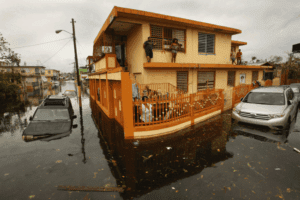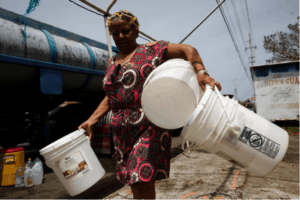
In Hurricane Maria’s wake, Puerto Rico went from a bustling tourism destination to an entire territory resembling Tornado Alley. The demolished and nonexistent infrastructure is devastating, but this is only the beginning of the uphill battle for Puerto Rico. Roads are impassable, standing water drowns the terrain, and water and food contamination are on the rise. One of the most infamous diseases known to flourish from water and food contamination is cholera. Puerto Rico could potentially see an outbreak in the coming weeks or months.
Post-Hurricane Maria Puerto Rico:
- Nearly 100% of Puerto Rico is without power and could endure 3-4 months without it.
- Almost half of the country, nearly 44 percent of the Puerto Rican population, lacks clean drinking water.
- Only 11 of the country’s 69 hospitals have access to fuel and power. Among the few hospitals with power, they have been subject to power outages and resource shortages.
Cholera Exploits Infrastructure Loss
Cholera is a deadly bacterial disease present in contaminated food and water and causes severe dehydration. Effective treatment requires aggressive rehydration therapy, but for a country like Puerto Rico, it seems that the situation will only continue to worsen without functioning water purification systems and a lack of reliable food sources.
Cholera flourishes alongside unsafe drinking water and infrastructure loss, while exploiting vulnerable populations displaced by the disaster. Many epidemics emerge when nations are at their weakest. Following the infamous 7.0 magnitude earthquake of 2010 in Haiti, cholera has continued to threaten the country, but the nation wasn’t prepared for the devastation caused by the reintroduction of the disease in 2015 after Hurricane Matthew. Another cholera epidemic emerged after the second round of severe infrastructure damage.

Risk Analysis
Although the conditions are favorable for a cholera outbreak, the likelihood of an outbreak developing is low; however, other diseases could arise from water contamination. “Wide-spread difficulty accessing clean water is forcing residents to use non-traditional sources for water,” states Dr. Sean Siler, VIGILINT’s CEO, President, and Chief Medical Officer. “This increases the transmission of many types of diseases, including Diarrhea caused by Giardia and Campylobacter, as well as hepatitis A. However, the CDC currently thinks cholera will not be likely given the absence of the bacteria on the Island before the hurricanes. Those diseases that were present before the storms will become more prevalent given the contamination of water sources, as well as standing water where mosquitos breed and can spread disease.”
In an email exchange with Dr. Peter Marghella, Special Advisor to Puerto Rico’s Secretary of Health, Marghella reinforced the devastating effects of Hurricane Maria. The Special Advisor stated, “as we move out from the storm impact, the degradations will conspire to create increases in morbidity and mortality, most through acute diarrheal illness and spikes in childhood morbidity normally controlled with vaccines.” Dr. Marghella references this recurrent phenomenon as “The Burkle Effect.”
Operating hospitals on the island are at capacity and do not have the proper resources to care for patients if an epidemic did arise. The disease could spread rapidly and leave many at a loss for treatment, adding another devastating element to the current situation.
Prevention
At this time, travelers should limit their travel to Puerto Rico. The health dangers in Puerto Rico pose a high risk to travelers. If one plans to travel to the U.S. territory, it is important to use bottled water for drinking and all food preparation. Frequent handwashing and hygiene practices will also reduce the risk for contraction.
VIGILINT will continue to monitor the situation and update projections as necessary.
